牛津英语7A_Unit3_全部教案
上海牛津英语7a教案
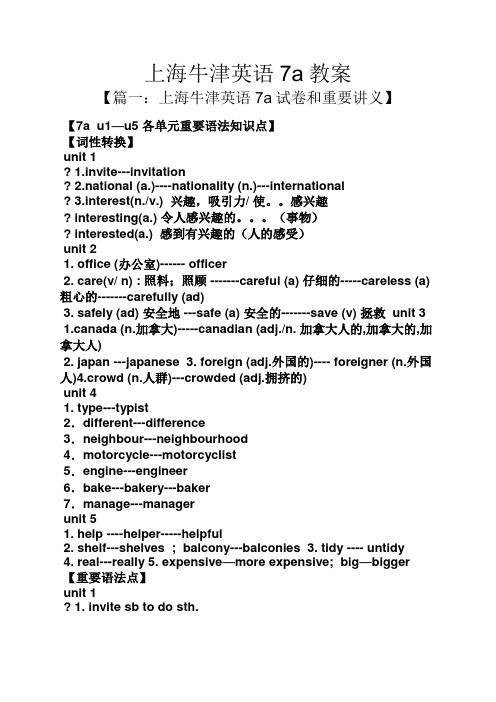
上海牛津英语7a教案【篇一:上海牛津英语7a试卷和重要讲义】【7a u1—u5 各单元重要语法知识点】【词性转换】unit 1? 1.invite---invitation? 2.national (a.)----nationality (n.)---international? 3.interest(n./v.) 兴趣,吸引力/ 使。
感兴趣? interesting(a.) 令人感兴趣的。
(事物)? interested(a.) 感到有兴趣的(人的感受)unit 21. office (办公室)------ officer2. care(v/ n) : 照料;照顾 -------careful (a) 仔细的-----careless (a) 粗心的-------carefully (ad)3. safely (ad) 安全地 ---safe (a) 安全的-------save (v) 拯救 unit 3 1.canada (n.加拿大)-----canadian (adj./n. 加拿大人的,加拿大的,加拿大人)2. japan ---japanese3. foreign (adj.外国的)---- foreigner (n.外国人)4.crowd (n.人群)---crowded (adj.拥挤的)unit 41. type---typist2.different---difference3.neighbour---neighbourhood4.motorcycle---motorcyclist5.engine---engineer6.bake---bakery---baker7.manage---managerunit 51. help ----helper-----helpful2. shelf---shelves ; balcony---balconies3. tidy ---- untidy4. real---really5. expensive—more expensive; big—bigger 【重要语法点】unit 1? 1. invite sb to do sth.? 2. talk to/ with sb. ? 4. talk about sth. (talk to sb about sth) ? 3. on+具体几月几日,on aug.16/ on 16 august 注意读音 ? 4. thank you for+ n.----thank you for your help. thank youfor+ doing---- thank you for writing to me. ? 5. more than = over 超过? 6. the summer palace; the great wall ; the palace museum ? tian’anmen square; yu garden7. see sb doing sth.与 see sb do sth 之间的区别? 8. it takes me 2 hours to finish my homework.?how long does it take you to finish your homework?9. 现在完成时态简单介入:例如: they ha ven’t been to the usa before.i haven’t finished my homework yet.she has already cleaned the classroom.10. another例如:this book is too difficult for me. will you please give me another one?unit 21. have no food or water 在否定句中and应改为“or”2. take sb to somewhere 带某人去某地3. take care of = care for = look after 照顾,照看4. buy sb sth = buy sth for sb 为某人买某物5. save animals from danger 把动物从危险中解救出来6. promise to do 承诺做某事7. 一般过去时态介入8. 名词+ to do,to do 用来补充说明用途例如:give him some water to drink;give him a blanket to keep warm;give it a basket to sleep inunit 31. six million 注意数字表达法:例如:2,700,560 two million seven hundred thousand five hundred and sixty2. 注意国家名称和国籍的区别。
牛津译林版英语七年级下册Unit3教案优秀教学案例
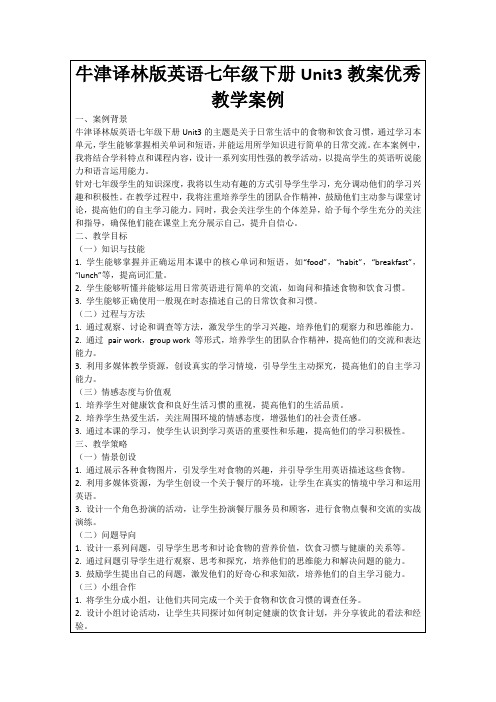
4.反思与评价:在课堂的最后阶段,我引导学生进行自我反思,思考自己在课堂上的学习收获和需要改进的地方。这个环节让学生更加关注自己的学习过程,有助于他们提高学习效果。
10.教学语言人性化:在整个教学过程中,我使用了人性化的语言,与学生建立了良好的互动关系。这有助于营造一个轻松愉快的学习氛围,提高学生的学习兴趣。
1.通过观察、讨论和调查等方法,激发学生的学习兴趣,培养他们的观察力和思维能力。
2.通过pair work,group work等形式,培养学生的团队合作精神,提高他们的交流和表达能力。
3.利用多媒体教学资源,创设真实的学习情境,引导学生主动探究,提高他们的自主学习能力。
(三)情感态度与价值观
1.培养学生对健康饮食和良好生活习惯的重视,提高他们的生活品质。
3.设计一个角色扮演的活动,让学生扮演餐厅服务员和顾客,进行食物点餐和交流的实战演练。
(二)问题导向
1.设计一系列问题,引导学生思考和讨论食物的营养价值,饮食习惯与健康的关系等。
2.通过问题引导学生进行观察、思考和探究,培养他们的思维能力和解决问题的能力。
3.鼓励学生提出自己的问题,激发他们的好奇心和求知欲,培养他们的自主学习能力。
3.引入本课的主题:“今天我们将会学习关于食物和饮食习惯的英语表达。”
(二)讲授新知
1.教授本课的核心单词和短语,如“food”,“habit”,“breakfast”,“lunch”等,并让学生进行反复练习。
2.通过例句和情景展示,教授一般现在时态的用法,并让学生进行句子练习。
最新-七年级英语上册Unit3教学案(版共10课时)牛津译林版精品
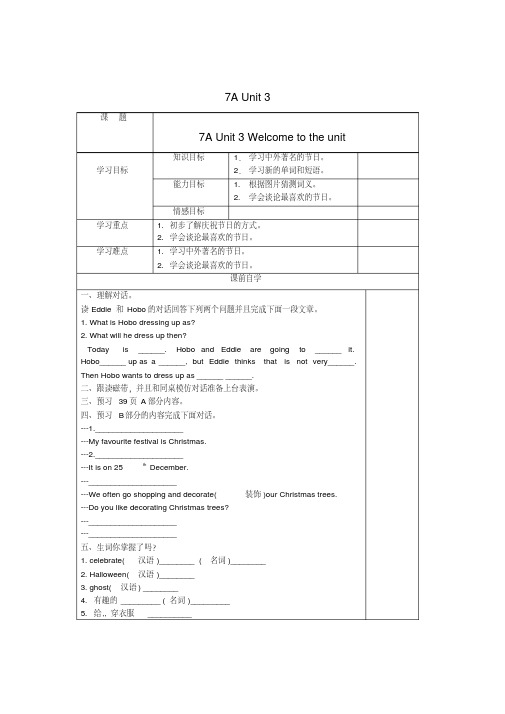
7A Unit 3课题7A Unit 3 Welcome to the unit学习目标知识目标1.学习中外著名的节日。
2.学习新的单词和短语。
能力目标 1.根据图片猜测词义。
2.学会谈论最喜欢的节日。
情感目标学习重点 1. 初步了解庆祝节日的方式。
2. 学会谈论最喜欢的节日。
学习难点 1. 学习中外著名的节日。
2. 学会谈论最喜欢的节日。
课前自学一、理解对话。
读Eddie和Hobo的对话回答下列两个问题并且完成下面一段文章。
1. What is Hobo dressing up as?2. What will he dress up then?Today is ______. Hobo and Eddie are going to ______ it. Hobo______ up as a ______, but Eddie thinks that is not very______. Then Hobo wants to dress up as ______ ______.二、跟读磁带,并且和同桌模仿对话准备上台表演。
三、预习39页A部分内容。
四、预习B部分的内容完成下面对话。
---1.____________________---My favourite festival is Christmas.---2.____________________---It is on 25th December.---____________________---We often go shopping and decorate(装饰)our Christmas trees.---Do you like decorating Christmas trees?---____________________---____________________五、生词你掌握了吗?1. celebrate(汉语)________ (名词)________2. Halloween(汉语)________3. ghost(汉语) ________4. 有趣的_________ (名词)_________5. 给,,穿衣服__________6. Monkey King(汉语)__________7. Christmas(汉语)___________8. Dragon Boat Festival(汉语)________________9. Mid-Autumn Festival(汉语)_______________10. Thanksgiving Day(汉语)________________11. moon cake(汉语)_________________六、补全单词。
Unit 3 Welcome to our school单词详解 教案 新牛津译林版英语七年级上册
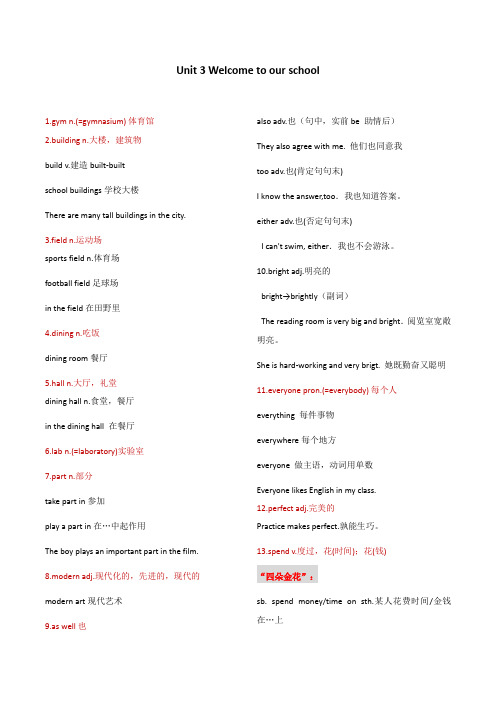
Unit 3 Welcome to our school1.gym n.(=gymnasium)体育馆2.building n.大楼,建筑物build v.建造built-builtschool buildings学校大楼There are many tall buildings in the city. 3.field n.运动场sports field n.体育场football field足球场in the field在田野里4.dining n.吃饭dining room餐厅5.hall n.大厅,礼堂dining hall n.食堂,餐厅in the dining hall 在餐厅b n.(=laboratory)实验室7.part n.部分take part in参加play a part in在…中起作用The boy plays an important part in the film.8.modern adj.现代化的,先进的,现代的modern art现代艺术9.as well也also adv.也(句中,实前be 助情后)They also agree with me. 他们也同意我too adv.也(肯定句句末)I know the answer,too.我也知道答案。
either adv.也(否定句句末)I can't swim, either.我也不会游泳。
10.bright adj.明亮的bright→brightly(副词)The reading room is very big and bright.阅览室宽敞明亮。
She is hard-working and very brigt. 她既勤奋又聪明11.everyone pron.(=everybody)每个人everything 每件事物everywhere每个地方everyone 做主语,动词用单数Everyone likes English in my class.12.perfect adj.完美的Practice makes perfect.孰能生巧。
牛津英语7A Unit 3 welcome to our school 知识点总结梳理
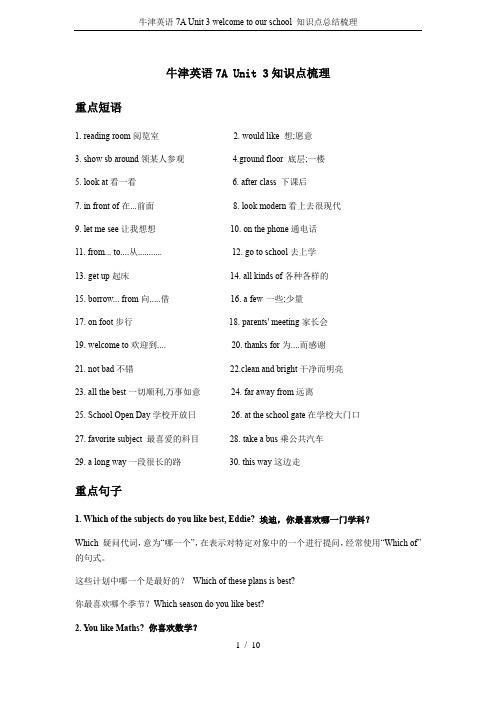
牛津英语7A Unit 3知识点梳理重点短语1. reading room阅览室2. would like 想;愿意3. show sb around领某人参观4.ground floor 底层;一楼5. look at看一看6. after class 下课后7. in front of在...前面8. look modern看上去很现代9. let me see让我想想10. on the phone通电话11. from... to....从........... 12. go to school去上学13. get up起床14. all kinds of各种各样的15. borrow... from向.....借16. a few-一些;少量17. on foot步行18. parents' meeting家长会19. welcome to欢迎到.... 20. thanks for为....而感谢21. not bad不错22.clean and bright干净而明亮23. all the best一切顺利,万事如意24. far away from远离25. School Open Day学校开放日26. at the school gate在学校大门口27. favorite subject 最喜爱的科目28. take a bus乘公共汽车29. a long way一段很长的路30. this way这边走重点句子1. Which of the subjects do you like best, Eddie? 埃迪,你最喜欢哪一门学科?Which 疑问代词,意为“哪一个”,在表示对特定对象中的一个进行提问,经常使用“Which of”的句式。
这些计划中哪一个是最好的?Which of these plans is best?你最喜欢哪个季节?Which season do you like best?2. You like Maths? 你喜欢数学?此处陈述句加问号,朗读时用升调,表示疑问,一般用来表示对某事不确定、惊奇或怀疑等。
牛津译林版英语7A Unit3 Reading课件

1. Sunshine Middle School looks beautiful. __T__
2. Millie and her mum are behind the classroom
building.
__F__
3. Millie’s classroom is on the ground floor.___T__
1. Recite the dialogue. 2. Write a short passage about your
school.
•不习惯读书进修的人,常会自满于现状,觉得再没有什么事情需要学习,于是他们不进则退。经验丰富的人读书用两只眼睛,一只眼睛看到纸面上的话,另 一眼睛看到纸的背面。2022年4月10日星期日2022/4/102022/4/102022/4/10 •书籍是屹立在时间的汪洋大海中的灯塔。2022年4月2022/4/102022/4/102022/4/104/10/2022 •正确的略读可使人用很少的时间接触大量的文献,并挑选出有意义的部分。2022/4/102022/4/10April 10, 2022 •书籍是屹立在时间的汪洋大海中的灯塔。
e.g. What’s the building over there. 8. the man in the white shirt
穿白色衬衫的那个人 这里 in的意思是“ 穿着, 戴着 ” e.g. Who’s the man in the white shirt?
一、根据首字母或汉语提示完成单词。
( ) big and modern
Art room(s): Music room(s): Library: School hall:
(√ ) one
( ) two
牛津译林版英语7AUnit3Grammar优秀教学案例
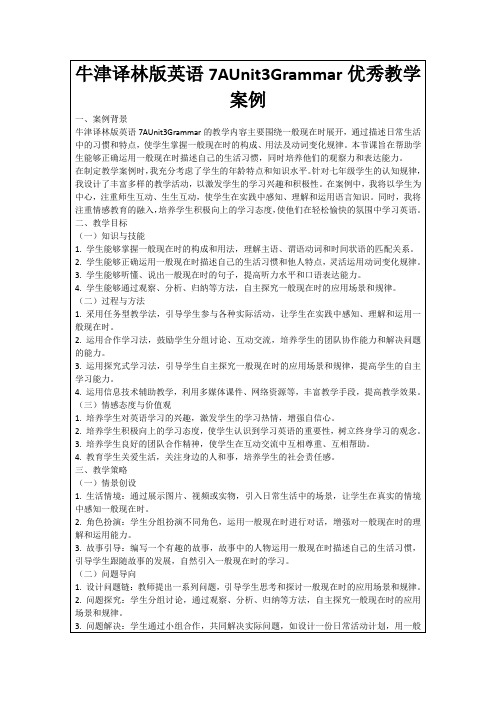
1.采用任务型教学法,引导学生参与各种实际活动,让学生在实践中感知、理解和运用一般现在时。
2.运用合作学习法,鼓励学生分组讨论、互动交流,培养学生的团队协作能力和解决问题的能力。
3.运用探究式学习法,引导学生自主探究一般现在时的应用场景和规律,提高学生的自主学习能力。
4.运用信息技术辅助教学,利用多媒体课件、网络资源等,丰富教学手段,提高教学效果。
2.实例展示:教师展示一些一般现在时的句子,让学生观察和理解主语、谓语动词和时间状语的匹配关系。
3.互动练习:教师邀请学生上台演示一般现在时的句子,并让学生互相纠正和反馈。
(三)学生小组讨论
1.任务分配:教师将学生分成小组,每组选择一个日常活动,如“洗澡”、“刷牙”等,用一般现在时描述该活动的习惯。
3.合作学习法:鼓励学生分组讨论、互动交流,培养学生的团队协作能力和解决问题的能力。
4.探究式学习法:引导学生自主探究一般现在时的应用场景和规律,提高学生的自主学习能力。
5.信息技术辅助教学:利用多媒体课件、网络资源等,丰富教学手段,提高教学效果。
2.小组讨论:学生小组内讨论,运用一般现在时描述活动,如“We brush our teeth every morning and evening.”
3.分享展示:每个小组向全班展示他们的讨论结果,其他小组进行评价和反馈。
(四)总结归纳
1.教师引导学生总结一般现在时的构成、用法和动词变化规律。
2.学生通过观察和分析,归纳出一般现在时的应用场景,如描述日常习惯、特点等。
1.小组讨论:学生分组讨论,分享自己的生活习惯和他人特点,运用一般现在时进行描述,互相交流和学习。
2.小组合作:学生分组完成任务,如共同设计一个班级活动,用一般现在时描述活动的内容和要求。
牛津初中英语7A_Unit3_教学要求,知识点讲解和练习 无
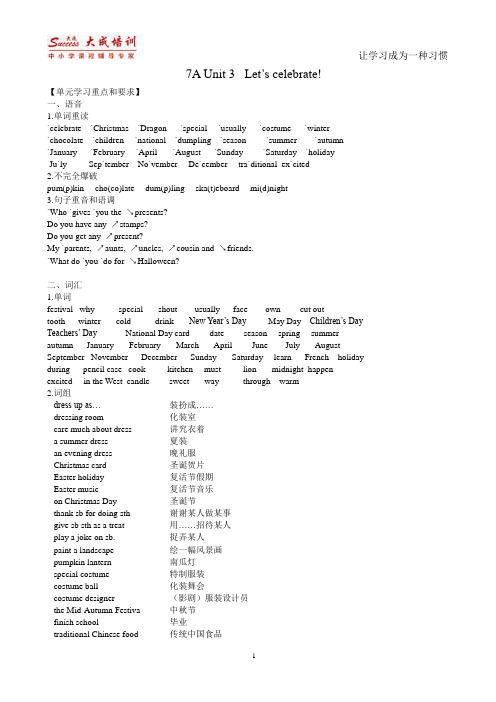
7A Unit 3 Let‟s celebrate!【单元学习重点和要求】一、语音1.单词重读`celebrate `Christmas `Dragon `special `usually `costume `winter`chocolate `children `national `dumpling `season `summer `autumn`January `February `April `August `Sunday `Saturday `holidayJu`ly Sep`tember No`vember De`cember tra`ditional ex`cited2.不完全爆破pum(p)kin cho(co)late dum(p)ling ska(t)eboard mi(d)night3.句子重音和语调`Who `gives `you the ↘presents?Do you have any ↗stamps?Do you get any ↗present?My `parents, ↗aunts, ↗uncles, ↗cousin and ↘friends.`What do `you `do for ↘Halloween?二、词汇1.单词festival why special shout usually face own cut outtooth winter cold drink New Y ear‟s Day May Day Children‟s Day Teachers‟ Day National Day card date season spring summer autumn January February March April June July August September November December Sunday Saturday learn French holiday during pencil case cook kitchen must lion midnight happen excited in the West candle sweet way through warm2.词组dress up as…装扮成……dressing room 化装室care much about dress 讲究衣着a summer dress 夏装an evening dress 晚礼服Christmas card 圣诞贺片Easter holiday 复活节假期Easter music 复活节音乐on Christmas Day 圣诞节thank sb for doing sth 谢谢某人做某事give sb sth as a treat 用……招待某人play a joke on sb. 捉弄某人paint a landscape 绘一幅风景画pumpkin lantern 南瓜灯special costume 特制服装costume ball 化装舞会costume designer (影剧)服装设计员the Mid-Autumn Festiva 中秋节finish school 毕业traditional Chinese food 传统中国食品lion dance 狮子舞buy sb sth=buy sth for sb 为某人买某物buy sth from (of) sb. 从某人处购买某物National Day 国庆节rice dumplings 粽子三、日常用语What are you cooking?Why do you like fishing?Where are you going?Which is your favorite festival?Thank you for telling me about the Mid-Autumn Festival.It is wonderful!Happy Halloween!四、语法: 表示时间的介词at常用来表示在某点时间,即“在几点几分;在某一时刻”。
- 1、下载文档前请自行甄别文档内容的完整性,平台不提供额外的编辑、内容补充、找答案等附加服务。
- 2、"仅部分预览"的文档,不可在线预览部分如存在完整性等问题,可反馈申请退款(可完整预览的文档不适用该条件!)。
- 3、如文档侵犯您的权益,请联系客服反馈,我们会尽快为您处理(人工客服工作时间:9:00-18:30)。
Unit 3 Let’s celebrate!Period(1)Comic strip+ Welcome to the unit一教学目标1能听、说、读、写单词holiday, as, monkey, why, mooncake, 并了解其含义。
能听懂、会说单词celebrate, ghost, king, festival, Christmas, Easter,短语dress up, the Mid-Autumn Festival,能理解单词dragon, Halloween,短语the Dragon Boat Festival。
2能了解中外一些重要的节假日及主要庆祝方式,从而激发对本单元的学习兴趣,并初步培养自己的世界文化意识。
3能就有关“个人对节日的喜好”情况相互进行简单询问及回答。
4能在教师的指导下,参与简单的角色扮演活动。
二教学重点1日常交际用语和生词的正确读音;2能模仿第35页Part B的对话,简单谈论个人对节假日的喜好情况。
三教学难点1能根据相关情景,正确地理解,区分相应的节假日名称;2能初步在情景中运用本课所学的互相询问节假日的交际用语。
四课前准备1教具准备:实物投影仪幕布、四幅卡通漫画图片(第3页)、六幅图片(第35页Part A)、一张人物图片(《西游记》中孙悟空的形象)。
2教学准备:请学生准备一张白纸并两人一组讨论写出他们所知道的节日名称(中文)。
3板书准备:黑板上预先写好课题Unit 3 Let‘s celebrate!五教学步骤(第34页Comic strip)1 教师用实物投影出示第34页卡通图片,指着图片说Look! We can see Eddie and Hobo again.(图片1)问:What are they doing? Can you guess? 帮助学生回答:I think they‘re celebrating their holiday.学习并操练单词:celebrate, holiday。
Holiday—the day you don‘t have to go to school.Celebrate—do something for the day.(图片3)问:What is Eddie doing? (He‘s dressing up as a ghost)用手势或其它动作、表情教学生短语dress up as……和单词ghost。
然后问:Do you like dressing up as a ghost?(No, we don‘t). Eddie doesn‘t like, either.(图片4)问:What‘s Hobo dressing up as now?(He is dressing up as Monkey King).学习单词monkey和king.教师出示孙悟空图片,Do you know him? We often call him Monkey King.(可以让喜欢孙悟空的学生模仿其造型)Who can dress up as Monkey King?(5分钟)2 让学生分角色朗读。
(2分钟)3 学生两人一组练习对话,并轮流扮作Eddie和Hobo,几分钟后,让一些小组到前面表演,鼓励学生自由发挥,尽量用自己的造型。
(5分钟)六教学步骤(第35页Welcome to the unit)1老师让学生展示事先准备好的节日清单并称赞:V ery good! 介绍课本内容:In this unit, I will help you to learn more about the Festivals in English.学习单词festival(s),并写在黑板上。
用实物投影出示第35页Part A图片(按以下顺序介绍)图片2—→图片4—→图片6—→图片5—→图片3—→图片1中国节日:直接用英语教短语Mid-Autumn Festival, Chinese New Year, Dragon Boat Festival,并写在黑板上。
西方节日:允许学生先用中文猜测,然后告诉他们:In English, we call it Christmas/Easter/Halloween,并逐词写在黑板上。
(5分钟)2领读数遍单词、短语后,再用实物投影出示第35页Part A图片,询问学生:What‘s the name of the festival? 然后学生两人一组活动,互相问答。
(5分钟) 3告诉学生:My favourite festival is Mid-Autumn Festival. Do you know why?Because I like to eat mooncakes.学习单词mooncake,可用简笔画来表示,相信学生能猜出其含义。
板书:My favourite festival is……Because I like to ……要求学生仿照黑板上的例句介绍自己的喜好情况,展开小组交流活动。
老师可巡视,进行必要帮助。
(5分钟)4打开书,带领学生富有感情地朗读Part B,采用男女生分组分角色方式朗读。
(2分钟) 5学生两人一组练习对话,再进行表演。
(4分钟)6让学生用自己的信息替换划线部分,鼓励他们用真实情况来表演对话,可四人一组活动。
为方便学生自如地表达,老师可提供以下词汇并板书:eat chocolate/make pumpkin Lanterns.eat rice dumplings/get Christmas presents/(此举也为以后的阅读教学带来方便。
)(5分钟) 7选出几组同学到前面表演,可让他们看黑板上的选用词汇。
鼓励他们增加动作,提高表演欲望。
在表演以后,领着其他同学给予掌声鼓励。
Don‘t you think they‘re very good?(Yes)Let‘s give them a big hand. (3分钟)七家庭作业熟读第34页、35页对话。
抄写本课所学节日名称。
鼓励有条件、特长的学生课外制作南瓜灯剪纸、手提灯笼及面具等,或画出相应的图片也可。
(2分钟)Period(2)Reading: A Getting ready for Halloween一教学目标1听、说、读、写单词USA,special, shout, if, face, own, cut, sharp(adj), tooth, chocolate, winter, drink,短语cut out并了解其含义。
能听懂、会说单词trick, treat, knock, candy, mask, paint, lantern, sharp(n)短语trick or treat,play a trick。
能理解单词costume, pumpkin。
2能正确理解本课课文,就获取的信息进行相互询问及回答。
3能通过本课学习,对英语国家的文化习俗产生兴趣。
二教学重点1生词和短语的正确读音。
2能通过阅读准确获取信息并能基本正确地朗读课文。
三教学难点1能在教师的指导下,简单地复述故事。
2能通过对西方节日及庆祝方式的进一步了解和中外文化对比,加深对中国文化的理解。
四课前准备1教具准备:磁带、录音机、实物投影仪幕布、三幅图片(第35页Part A中的图1、2、3)。
2教学准备:请学生准备事先制作好的道具或图片。
3板书准备:黑板上预先写好课题Unit 3 Let‘s celebrate!五教学步骤(第36—37页)1 教师用实物投影展示第35 页Part A 图2,问:What‘s the name of the festival?(It‘sMid-Autumn Festival)指着图中男孩提着的灯笼,教单词Lantern: This is a lantern in English.教师说:Show me your lanterns, please! 让学生出示他们制作的实物或图片。
接着,展示图片1:What‘s the name of the festival?(It‘s Halloween).告诉学生:This is a pumpkin lantern.把lantern写在黑板上。
最后展示图片3。
让一学生用第35页Part B的对话发问:Which is your favourite festival?(Easter)Why do you like it?(Because I like to eat chocolate eggs .(用手指着图片中的chocolate eggs),再板书chocolate。
(5分钟)2 介绍课本内容:Today we‘re going to learn something about Halloween .In China, we do notcelebrate Halloween. But in the USA , people celebrate it. They have a special party on that day.And they play a game called ―trick or treat‖, They also wear different costumes with masks.They even paint their faces. People do not know each other. They make pumpkin lanterns, eat a lot of chocolates and candies. Don‘t you think how interesting it is?(Yes).教师伴着手势、表情,借助于学生手中的实物或图片,给学生简单描述,并将上文的划线部分写在黑板上,然后让学生分组展开讨论:What do people in the USA do for Halloween? 组织学生收集信息,并互相交流。
(7分钟)3放课文录音,听一遍。
Now, please listen to the tape. This is a letter from Wendy to Millie. Try to answer: When is Halloween? 并把答案(On October 31st)写在黑板上。
(3分钟)4打开书本,让学生细读一遍课文,然后就课文内容提一些问题Paragraph1: What‘s Wendy‘s favourite festival?Paragraph2: How do you play the game called ―trick or treat‖?Paragraph3: How do they dress up at Halloween?Paragraph4: How do you make your own pumpkin lantern?Paragraph5: What do they eat on that day?学生分组讨论及交流问题答案。
